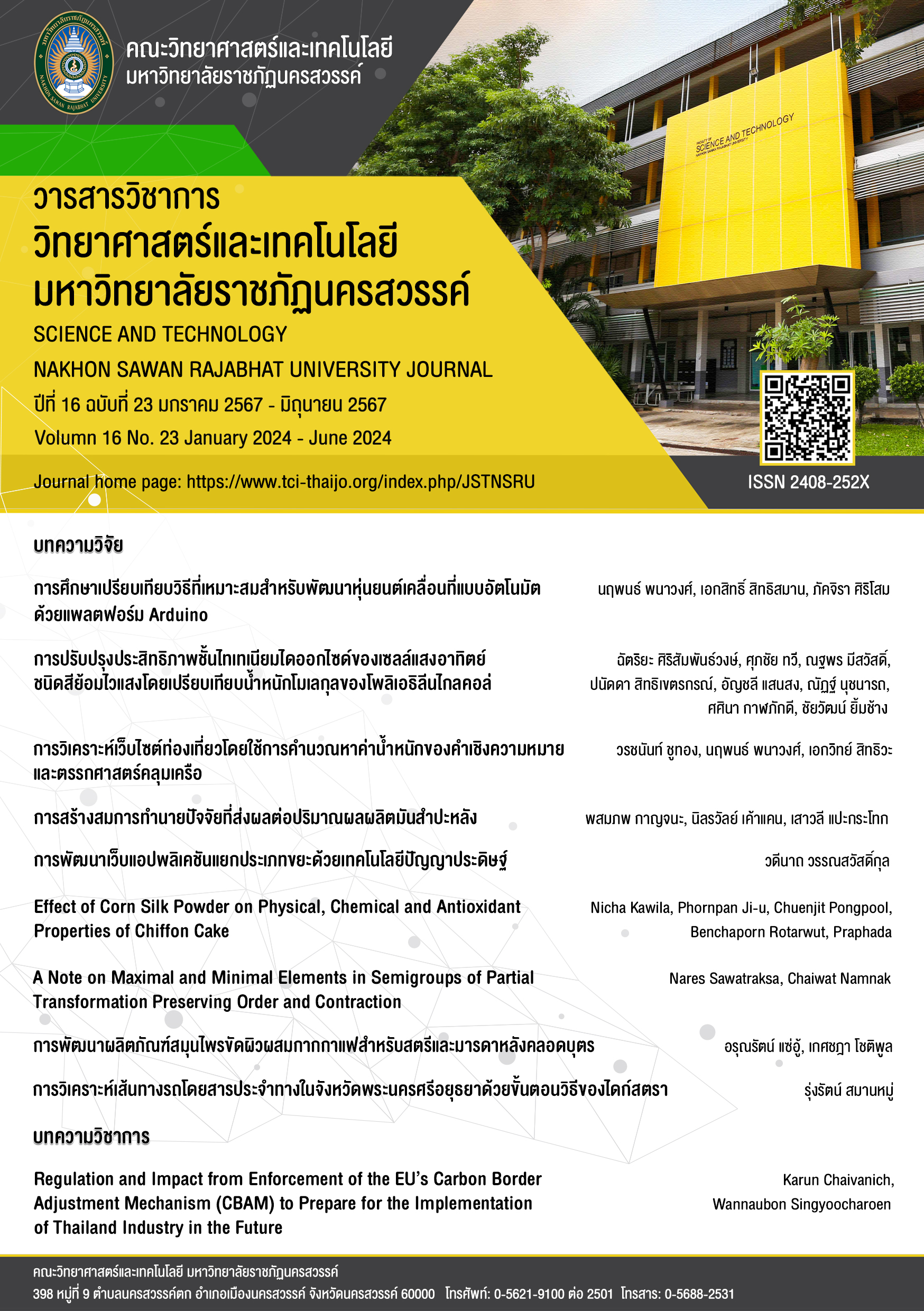การวิเคราะห์เว็บไซต์ท่องเที่ยวโดยใช้การคำนวณหาค่าน้ำหนักของคำเชิงความหมาย และตรรกศาสตร์คลุมเครือ
Main Article Content
Abstract
งานวิจัยนี้มีวัตถุประสงค์เพื่อวิเคราะห์เว็บไซต์ท่องเที่ยว โดยใช้เทคนิคการคํานวณหาค่าน้ำหนักของคําเชิงความหมายและตรรกศาสตร์คลุมเครือ และวัดประสิทธิภาพของเทคนิคนี้ด้วย F-Measure การวิจัยประกอบด้วย 3 ขั้นตอน กล่าวคือ (1) การออกแบบสถาปัตยกรรมของการวิเคราะห์เว็บไซต์ท่องเที่ยว ที่นำเสนอภาพรวมของงานวิจัย และการสร้างคําสำคัญเชิงความหมายจากออนโทโลจีการท่องเที่ยว และคําสำคัญที่ปรากฏร่วมกันบ่อยในเว็บไซต์ (2) การวิเคราะห์เว็บไซต์ด้วยการเขียนโค้ดภาษา Python เพื่อนำเนื้อหามาจาก Body tags ของเว็บไซต์ อีกทั้งนำผลลัพธ์การสืบค้นมาจากเว็บไซต์กูเกิล โดยใช้ 647 เว็บไซต์ท่องเที่ยวจาก Truehits มาเรียนรู้ จากนั้นคํานวณหาค่าน้ำหนักของคําเชิงความหมายจำนวน 68 คํา และคํานวณหาความน่าจะเป็นของแต่ละเว็บไซต์ และ (3) การตั้งค่าเขตแดนโดยใช้ตรรกศาสตร์คลุมเครือที่กำหนดความเป็นสมาชิกด้วยค่า F-Measure โดยใช้ฟังก์ชันสามเหลี่ยมมาสร้างกฎฟัซซีแบบ IF <condition> THEN จำนวน 5 กฎ ช่วยอนุมานและหาจุดศูนย์ถ่วงสำหรับค่าเขตแดนอันเหมาะสมที่สุด ผลการวิเคราะห์ ทราบค่าเขตแดนอันเหมาะสมที่สุดเท่ากับ 10.65 จากการทดสอบกับเว็บไซต์ท่องเที่ยวจำนวน 500 เว็บไซต์ พบว่า มีเว็บไซต์ที่เกี่ยวข้องกับการท่องเที่ยว คิดเป็นร้อยละ 83.80 โดยมีค่าประสิทธิภาพเท่ากับร้อยละ 93.21 มีค่าความแม่นยําเฉลี่ยเท่ากับร้อยละ 100 และค่าความระลึกเฉลี่ยเท่ากับร้อยละ 87.29
Article Details

This work is licensed under a Creative Commons Attribution-NonCommercial-NoDerivatives 4.0 International License.
References
คมคิด ชัชราภรณ์, ธรา อั่งสกุล และ จิติมนต์ อั่งสกุล. (2555). แบบจำลองการจัดหมวดหมู่สถานที่ท่องเที่ยวโดยใช้เทคนิคการเรียนรู้ของเครื่อง. วารสารเทคโนโลยีสุรนารี, 6(2), 35-58. https://so05.tcithaijo.org/index.php/sjss/article/view/81977
ตฤณสิษฐ์ ไกรสินบุรศักดิ์, ประสาท แสงพันธุ์ตา, พุทธธินันทร์ จารุวัฒน์, อนุชา เชาว์โชติ, มงคล ตุ่นเฮ้า, นิรุติ บุญญา, มานพ คันธามารัตน์, รัชดา ปรัชเจริญวนิชย์, อนุสรณ์ เทียนศิริฤกษ์ และ กันต์ธกรณ์ เขาทอง. (2566). การจำลองการให้น้ำอ้อยด้วยตัวควบคุมแบบฟัซซี่. วารสารวิชาการเกษตร, 41(1). 80-90.
พิมพ์วิภา ตราชูวณิช และ ณัฐพงศ์ พันธ์น้อย. (2565). พฤติกรรมการท่องเที่ยวของนักท่องเที่ยวคุณภาพในบริบทประเทศไทย. สาระศาสตร์, 3, 497-508.
Adila, N., Sembiring, F., & Jatmiko, W. (2022). Implementation of Web Scraping for Journal Data Collection on the SINTA Website. Sinkron : Jurnal dan Penelitian Teknik Informatika, 7(4), 2478-2485. https://doi.org/10.33395/sinkron.v7i4.11576
Khder, M. A. (2021). Web Scraping or Web Crawling: State of Art, Techniques, Approaches and Application. International Journal of Advances in Soft Computing & Its Applications, 13(3), 144-168. https://doi.org/10.15849/IJASCA.211128.11
Kumar, N., Gupta, M., Sharma, D., & Ofori, I. (2022). Technical Job Recommendation System Using APIs and Web Crawling. Computational Intelligence and Neuroscience, 2022, 1-11, https://doi.org/10.1155/2022/7797548
Lin, P., Chen, L., & Luo, Z. (2022). Analysis of Tourism Experience in Haizhu National Wetland Park Based on Web Text. Sustainability, 14(5), 1-16. https://doi.org/10.3390/su14053011
Namahoot, C. S., Lobo, D., & Kabbua, S. (2014). Enhancement of a Text Clustering Technique for the Classification of Thai Tourism Websites. In EEEE, International Computer Science and Engineering Conference, (pp. 203-208). https://doi.org/10.1109/ICSEC.2014.6978195
Namahoot, C. S., & Lobo, D. (2019). A Thailand Tourism Web Analysis and Clustering Tool Using a Word Weight Calculation Algorithm. Journal of Computers, 30(2), 116-125. https://doi.org/10.3966/199115992019043002010
Nilashi, M, Yadegaridehkordi, E. Ibrahim, O., Samad, S., Ahani, A., & Sanzogni, L. (2019). Analysis of Travellers’ Online Reviews in Social Networking Sites Using Fuzzy Logic Approach. International Journal of Fuzzy Systems, 21, 1367-1378. https://doi.org/10.1007/s40815-019-00630-0
Panawong, N., & Sittisaman, A. (2019). Tourism Web Filtering and Analysis using Naïve Bay with Boundary Values and Text Mining. Advances in Intelligent Systems and Computing, 924, 535-547. https://doi.org/10.1007/978-981-13-6861-5_46
Sachenko, A., Banasik, A., & Kapczynski, A. (2009). The concept of Application of Fuzzy logic In Biometric Authentication Systems. Springer-Verlag Berlin Heidelberg, 53, 274-279. https://doi.org/10.1007/978-3-540-88181-0_35
Sahu, S., Divya, K., Rastogi, N., Yadav, P. K., & Perwej, Y. (2022). Sentimental Analysis on Web Scraping Using Machine Learning Method. Journal of Information and Computational Science, 12(8), 24-29.
Similarweb. (2566, ตุลาคม). Top Websites Ranking. https://www.similarweb.com/top-websites/computers-electronics-and-technology/search-engines
Sittisaman, A., & Panawong, N. (2019). A Development of Real-time Tourism Information Recommendation System for Smart Phone Using Responsive Web Design, Spatial and Temporal Ontology. International Journal of Engineering and Advanced Technology, 8(5), 994-999. https://www.ijeat.org/wp-content/uploads/papers/v8i5/E7066068519.pdf


